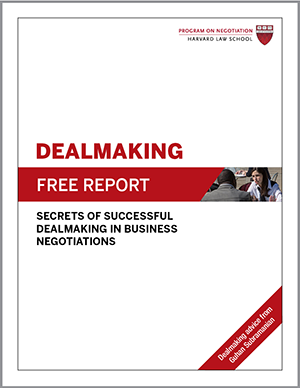
When a team negotiates on behalf of an organization, it can often achieve more than an individual would, thanks to team members’ cumulative knowledge and experience. Yet team negotiation can create new problems. Groupthink—the tendency to go along with the dominant point of view rather than challenging it—can promote overly simplistic decision making in teams and lead to serious problems. And a bias toward one’s own team can lead negotiators to distrust the other side’s team and be overly competitive, sacrificing value in the process.
Addressing Groupthink in Team Negotiation
In the 1970s, psychologist Irving L. Janis coined the term “groupthink” to describe the common tendency for members of a group to refrain from expressing their actual views for fear of being criticized or ostracized by the rest of the group. When a negotiation team succumbs to groupthink, team members may omit critical information when making decisions and overlook looming crises. To take two examples from history, Janis said that groupthink played a role in President John F. Kennedy’s botched 1961 Bay of Pigs invasion and the 1986 Challenger disaster.
How can you avoid groupthink in team negotiation? First, include people with diverse views, styles, and perspectives on your team, Lesley University president and conflict management expert Jeff Weiss suggested in an interview with NPR’s Marketplace. A wide range of opinions helps the team view a problem from all angles.
Second, encourage constructive dissent. Team members often avoid conflict, fearful of throwing negotiations offtrack and feeling uncomfortable. But constructive dissent—disagreeing respectfully and productively challenging others’ viewpoints—is critical to effective group negotiation and decision making, according to Harvard Business School professor Francesca Gino. When we feel free to disagree with others, we welcome new perspectives and promote a more thorough decision-making process.
In their research on team negotiation, University of Virginia professor Kristin Behfar and her colleagues found that different types of group conflict have different results. When negotiating teams disagree on substantive issues, such as interests, priorities, and goals, the process of group conflict resolution can lead them to better outcomes than if they hadn’t disagreed. But if the conflict veers offtrack and becomes personal, the team is likely to be far less productive.
“Once it becomes a personal battle, not only do you often end up losing people from your team,” says Weiss, “but you’re not getting the information . . . that at a nuanced level will help you as a leader make a decision.”
Learning to Cooperate and Compete
A second major bias that can hold back team negotiation is the tendency to view other groups and their members with hostility and suspicion. It’s common to become so loyal to our group that we look down on outsiders and distrust them. In a team negotiation, this in-group bias can lead parties to be overly competitive with each other and to overlook the value of collaborating to create value through wise tradeoffs.
In a 2018 study, Guihyun Park of Singapore Management University and Richard P. DeShon of Michigan State University compared two different strategies aimed at promoting high-quality decision making in groups with the goal of reducing intergroup competition. They formed three-person groups of participants and arranged for each group to play six rounds of the classic “prisoner’s dilemma” economic game, in which groups must decide whether to compete or collaborate with each other. Because of decision-making errors, groups often fail to recognize that they could earn the most money in the game by collaborating rather than competing.
Groups were assigned to one of three decision-making conditions and negotiated with a group in the same condition. In the “structured discussion” condition, groups were given a decision-making worksheet designed to encourage them to consider the pros and cons of cooperating and competing before making a decision. In the “cooperative-leader discussion” condition, the most cooperative member was chosen (based on the member’s expressed willingness to cooperate with the other team rather than compete) to lead the group’s decision-making discussion. Groups in the control condition were not steered toward a particular decision-making strategy.
Groups that engaged in structured discussion were more likely to cooperate with other groups as compared to groups in the cooperative-leader and control conditions. “A high-quality decision-making process encouraged groups to remain open and flexible in the face of intergroup conflict, and they became more effective in preventing later competitive interactions,” write Park and DeShon. By contrast, groups led by a cooperative member started off cooperative but became more competitive after several rounds of the game, to their detriment.
The results suggest that it’s not sufficient for a group leader to promote cooperative goals in team negotiation. Leaders need to actively encourage team members to think about and discuss in depth the choices they face.
What other advice do you have for promoting efficiency and mutually beneficial solutions in team negotiation?




